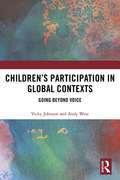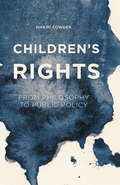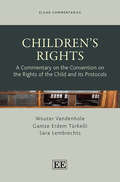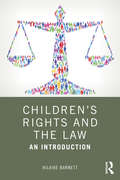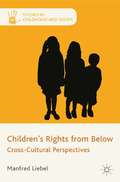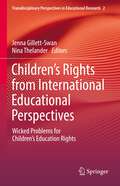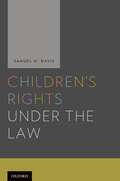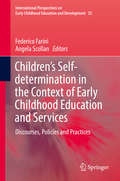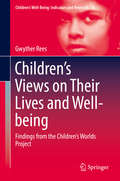- Table View
- List View
Children's Participation: The Theory and Practice of Involving Young Citizens in Community Development and Environmental Care
by Roger A. HartPeople's relationship to nature is the greatest issue facing the world at the turn of the millennium, and all over the world young people have shown enormous enthusiasm for environmental action. Many countries are radically reassessing both the role of citizens in managing their environment and the rights and responsibilities of children to be involved in shaping their own and their communities' futures. This book, by one of the world's leading authorities on environmental education, is written in the conviction that children can play a valuable and lasting role in sustainable development, if their participation is taken seriously and planned with thought for their developing capabilities and unique strengths. Through direct participation, children can develop a genuine appreciation of democracy and a sense of their own competence and responsibility. The planning, design, monitoring and management of the physical environment is an ideal domain for their participation, in part because their commitment to it is so strong. The book is for planners, educationalists and environmentalists, introducing the theory and the practice of children's participation, and its importance for developing democracy and sustainable communities. It emphasises genuine participation, where children are themselves involved in defining problems and acting as reflective, critical participants in issues affecting their communities. The 'environment' is interpreted broadly to include, for example, the planning of housing areas and the management of playgrounds. Detailed case studies are provided from urban and rural, poor and middle class communities from both the North and South. For teachers, group facilitators and community leaders, it presents organising principles, successful models, practical techniques and resources for involving young people in environmental projects.
Children’s Participation in Global Contexts: Going Beyond Voice
by Vicky Johnson Andy WestChildren's and young people’s right to participate has been increasingly acknowledged and taken up internationally, as expressed in the UN Convention on the Rights of the Child. Yet much of this has focused on collecting children’s voices, rather than achieving change, and has met its limits. This book provides an analysis of children’s participation in formal, collective and action research processes in six different international settings. It offers a deeper understanding of what helps and facilitates children's and young people’s participation through research, evaluation and decision-making to go beyond voice and effect change. This analysis is set in the context of historical and current discourses of participation, the sociology of childhood, contemporary anthropology, children’s geography and international development. Themes addressed include time and processes in children’s participation, shifting and multiple identities of children, political and cultural contexts, places and spaces children inhabit, skills and capacities of adults, accountability and power. The analysis promotes an approach to children’s participation as relational and collaborative, and will contribute to answering some of the questions facing practitioners and researchers embarking on participatory enquiry with children and young people. This is an invaluable book for practitioners and for scholars, postgraduates in anthropology, sociology, human geography, childhood studies, development studies, social policy, social work, community work, education, youth work and those with an interest in citizenship, children’s rights and human rights. Researchers and practitioners in UN, government and non-government services will also find it applicable to engaging with children and young people.
Children’s Participation in Global Contexts: Going Beyond Voice
by Vicky Johnson Andy WestChildren's and young people’s right to participate has been increasingly acknowledged and taken up internationally, as expressed in the UN Convention on the Rights of the Child. Yet much of this has focused on collecting children’s voices, rather than achieving change, and has met its limits. This book provides an analysis of children’s participation in formal, collective and action research processes in six different international settings. It offers a deeper understanding of what helps and facilitates children's and young people’s participation through research, evaluation and decision-making to go beyond voice and effect change. This analysis is set in the context of historical and current discourses of participation, the sociology of childhood, contemporary anthropology, children’s geography and international development. Themes addressed include time and processes in children’s participation, shifting and multiple identities of children, political and cultural contexts, places and spaces children inhabit, skills and capacities of adults, accountability and power. The analysis promotes an approach to children’s participation as relational and collaborative, and will contribute to answering some of the questions facing practitioners and researchers embarking on participatory enquiry with children and young people. This is an invaluable book for practitioners and for scholars, postgraduates in anthropology, sociology, human geography, childhood studies, development studies, social policy, social work, community work, education, youth work and those with an interest in citizenship, children’s rights and human rights. Researchers and practitioners in UN, government and non-government services will also find it applicable to engaging with children and young people.
Children's Rights: From Philosophy to Public Policy
by Mhairi CowdenDespite the existence of the UN Convention on the Rights of the Child there still exists a debate on whether children can really hold rights. This book presents a clear theory of children's rights by examining controversial case studies. The author presents a pathway to translating rights into practical social and political instruments for change.
Children’s Rights: A Commentary on the Convention on the Rights of the Child and its Protocols (Elgar Commentaries series)
by Wouter Vandenhole Gamze Erdem Türkelli Sara LembrechtsThis comprehensive Commentary presents a contemporary legal perspective on the inherently interdisciplinary field of children’s rights. Chapters analyse each article of the Convention on the Rights of the Child, along with its Optional Protocols, providing contextualised information on the interpretation and implementation of the children’s rights provisions therein. A detailed introduction examines the history of the Convention and places it within the wider landscape of human rights and other disciplinary approaches such as the sociology of childhood. The Commentary critically engages with the text of the Convention, exploring commonly used concepts and defining pertinent terminology. The authors draw on multiple perspectives and refer to disciplines outside of law to enrich the analysis of the articles, their interpretation and the study of children’s rights as a discipline. Featuring examples of case law from regional human rights systems this Commentary provides a well-rounded insight into the status of children's rights on a global scale. Written in an accessible style, this Commentary will be a valuable reference work for students, researchers, practitioners and policymakers alike. The Commentary will be of great interest to those working within children’s rights law and human rights law. Researchers in politics, sociology and international studies who are seeking further information and insight on the rights of children will also find this Commentary to be a useful point of reference.
Children’s Rights and International Development: Lessons and Challenges from the Field
by Myriam Denov & Richard Maclure & Kathryn CampbellA timely examination of the plight of children and youths in developing nations. The chapters strike a balance between diagnostic analysis of the conditions of risk, with prescriptive ideas for approaching and intervening with marginalized children.
Children's Rights and Participation in Residential Care (PDF)
by Carolyne WillowWhat rights do young people living in residential care have? How can residential staff and managers implement the United Nations Convention on the Rights of the Child? Why is participation important and how can adults help young people make decisions? Where can young people get independent help and advice? Children's Rights and Participation in Residential Care, the first practical guide of its kind, clearly addresses these - and many other - issues which were central to residential care in the 1990s. Arising from a two-year NCB project, this informative book charts the role of young people in developing and improving residential services and provides a comprehensive summary of research into young people's experiences. After outlining the legal entitlements of young people who live in residential care, the book provides many useful suggestions about how staff and managers can increase young people's participation. Children's Rights and Participation in Residential Care will prove invaluable to all those practitioners, managers and students who want to help create residential homes which respect and value the rights of young people.
Children's Rights and Social Work (SpringerBriefs in Rights-Based Approaches to Social Work)
by Hanita Kosher Asher Ben-Arieh Yael HendelsmanThis book provides a conceptual framework for children's rights as well as specific strategies and opportunities for social workers to apply in their work. It guides social work professionals and students through the history of children's rights. It also includes a call for a paradigm shift from a focus on the right to nurturance to the right to self-determination, as well as a contrasting look at children's rights in the West versus the rest of the world.
Children's Rights and the Law: An Introduction
by Hilaire BarnettThis book identifies the definition of a child within the law, the rights of children, and discusses the extent to which primarily English law gives adequate recognition to and protection of these rights. To what extent does English law gives adequate recognition to and protection of the rights of children? Historically the idea of and protection of rights has focused on parental rights rather than the rights of the child. The rights of children have remained far less recognised and certain until recently. Using case studies from the United Kingdom and beyond, this book takes a thematic approach to children’s rights and considers topics including: underlying concepts such as the welfare of the child and safeguarding, the right to education and to medical treatment, the right to freedom from abuse and/or sexual and commercial exploitation, including contemporary challenges from forced marriage, FGM, modern slavery and trafficking, the role of the State in relation to children in need of care and protection, children's rights in the criminal justice system, the right to contract and employment. In addition, the book provides an introduction to key aspects of domestic and international law, including the Children Act 1989, the UN Convention on the Rights of the Child, the European Convention on Human Rights and the Human Rights Act 1998. The book will be of great interest to law and social science students in the areas of Child Development and Protection, Human Rights Law, Family Law, Child Law, and Child Studies, as well as to social workers, police officers, magistrates, probation officers and other related professions.
Children's Rights and the Law: An Introduction
by Hilaire BarnettThis book identifies the definition of a child within the law, the rights of children, and discusses the extent to which primarily English law gives adequate recognition to and protection of these rights. To what extent does English law gives adequate recognition to and protection of the rights of children? Historically the idea of and protection of rights has focused on parental rights rather than the rights of the child. The rights of children have remained far less recognised and certain until recently. Using case studies from the United Kingdom and beyond, this book takes a thematic approach to children’s rights and considers topics including: underlying concepts such as the welfare of the child and safeguarding, the right to education and to medical treatment, the right to freedom from abuse and/or sexual and commercial exploitation, including contemporary challenges from forced marriage, FGM, modern slavery and trafficking, the role of the State in relation to children in need of care and protection, children's rights in the criminal justice system, the right to contract and employment. In addition, the book provides an introduction to key aspects of domestic and international law, including the Children Act 1989, the UN Convention on the Rights of the Child, the European Convention on Human Rights and the Human Rights Act 1998. The book will be of great interest to law and social science students in the areas of Child Development and Protection, Human Rights Law, Family Law, Child Law, and Child Studies, as well as to social workers, police officers, magistrates, probation officers and other related professions.
Children's rights, Eastern enlargement and the EU human rights regime (European Politics)
by Ingi IusmenThis book critically examines how and why Eastern enlargement has impacted on EU human rights policy. By drawing on the EU’s intervention in human rights provision in Romania before 2007, it is demonstrated that the feedback effects of this intervention have led to the emergence of an EU child rights policy. Eastern enlargement has also raised the profile of Roma protection, international adoptions and mental health at the EU level. The impact of these developments has been further reinforced by the constitutional and legal provisions included in the Lisbon Treaty. It is argued that Eastern enlargement has led to the emergence of a more robust and well-defined EU human rights regime in terms of its scope and institutional clout. This book makes a substantial contribution to the scholarship on EU enlargement, Europeanisation and EU human rights policy by providing empirical evidence for the emergence and persistence of EU institutional and policy structures upholding human rights.
Children's rights, Eastern enlargement and the EU human rights regime (European Politics)
by Ingi IusmenThis book critically examines how and why Eastern enlargement has impacted on EU human rights policy. By drawing on the EU’s intervention in human rights provision in Romania before 2007, it is demonstrated that the feedback effects of this intervention have led to the emergence of an EU child rights policy. Eastern enlargement has also raised the profile of Roma protection, international adoptions and mental health at the EU level. The impact of these developments has been further reinforced by the constitutional and legal provisions included in the Lisbon Treaty. It is argued that Eastern enlargement has led to the emergence of a more robust and well-defined EU human rights regime in terms of its scope and institutional clout. This book makes a substantial contribution to the scholarship on EU enlargement, Europeanisation and EU human rights policy by providing empirical evidence for the emergence and persistence of EU institutional and policy structures upholding human rights.
Children's Rights from Below: Cross-Cultural Perspectives (Studies in Childhood and Youth)
by M. LiebelThis book presents an integral, cross-cultural reflection on the social reality of children's rights and citizenship, giving an insight into new perspectives on the history and different concepts of children's rights in a contextualized and localized manner.
Children’s Rights from International Educational Perspectives: Wicked Problems for Children’s Education Rights (Transdisciplinary Perspectives in Educational Research #2)
by Jenna Gillett-Swan Nina ThelanderThis book critically examines contemporary educational practices with a children’s rights lens. Through investigating the factors that contribute to (or hinder) the realisation of children’s rights in and through education in different contexts, it discusses how using a rights framework for education furthers the agenda for achieving international educational aims and goals. Using diverse international examples, the book provides a snapshot of the complexity of children’s rights and education. It draws on the expertise of international research teams from Australia, England, Finland, Italy, Mexico, Poland, Portugal, Scotland, Spain, Sweden, Switzerland, and the United States, and highlights wide-ranging interpretations of the same mandate across different national contexts. Beginning with a critical overview of the broader context of children’s rights in education, the book explores obligations for States and their representatives, tensions and convergences in implementation, and implications for teaching and learning. Using underutilised educational and theoretical concepts, it contributes to broadening understandings of children’s rights, education and associated theoretical frameworks. Despite a human rights framework emphasising the indivisibility, interrelatedness and interconnectedness of all rights, the ‘right to education’ (Article 28) dominates discussions about children’s rights and education. As such, equally important rights including the ‘aims of education’ (Article 29) are often less considered or absent from the conversation. Recognising that children’s education rights involve more than just access and provision, this book advocates for a much broader understanding of the nuances underpinning children’s education related rights.
Children’s rights in crisis: Multidisciplinary, transnational, and comparative perspectives
by Salvador Santino F. RegilmeThis book rigorously investigates the contemporary state of children's rights and the multifaceted challenges facing children, uncovering the complexities at their core. In 1989, the United Nations introduced the Convention on the Rights of the Child (CRC), ratified by 196 nations, promising a world where children's rights would reign supreme. In practice, however, realising these rights proves intricate and often precarious. Policies may shine on paper, but their implementation grapples with the challenges posed by global governance structures, national strategies, and local factors. Over three decades since the CRC's inception, this book scrutinises the true efficacy of international commitments, shedding light on underexplored issues and revealing shortcomings in both discourse and actions. With diverse, interdisciplinary perspectives, it recognises the profound influence of global and transnational forces in generating outcomes that impact children’s rights and welfare.An electronic edition of this book is freely available under a Creative Commons (CC BY-NC-ND) licence.
Children’s rights in crisis: Multidisciplinary, transnational, and comparative perspectives
by Salvador Santino F. RegilmeThis book rigorously investigates the contemporary state of children's rights and the multifaceted challenges facing children, uncovering the complexities at their core. In 1989, the United Nations introduced the Convention on the Rights of the Child (CRC), ratified by 196 nations, promising a world where children's rights would reign supreme. In practice, however, realising these rights proves intricate and often precarious. Policies may shine on paper, but their implementation grapples with the challenges posed by global governance structures, national strategies, and local factors. Over three decades since the CRC's inception, this book scrutinises the true efficacy of international commitments, shedding light on underexplored issues and revealing shortcomings in both discourse and actions. With diverse, interdisciplinary perspectives, it recognises the profound influence of global and transnational forces in generating outcomes that impact children’s rights and welfare.An electronic edition of this book is freely available under a Creative Commons (CC BY-NC-ND) licence.
Children's Rights in International Politics: The Transformative Power of Discourse (Transformations of the State)
by A. HolzscheiterProvides insights into a lively field of international human rights politics – the protection of children and their rights – by looking at the negotiations leading to the 1989 UN Convention on the Rights of the Child.
Children's Rights in Ireland: Law, Policy And Practice
by Ursula Kilkelly"Dr. Kilkelly's newest book, Children's Rights in Ireland: Law, Policy, and Practice, is a most useful and significant legal treatise of interest not only in Ireland but to readers in all English speaking nations. This book provides a thorough review of the historical evolution of the rights of children, relevant theories, case law, legislation, and a review of the current and growing influence of international law in the realm of children's legal rights. Highly recommend for all person interested in the rights of children, and essential reading for legal scholars and practitioners working in this area of law". John Dayton, J.D., Ed. D., Professor and Co-Director, Education Law Consortium, University of Georgia.A unique legal analysis of child and family law from a children's rights perspective. This completely unique new title outlines current law, policy and practice as it relates to children in all areas of their lives. Written in a clear analytical style, it maps the legal landscape and highlights the key provisions and principles you need to navigate when handling cases involving children and families. No other book examines law and policy affecting children in such a comprehensive and detailed manner. It tackles a broad range of issues concerning children beyond traditional family law, including constitutional issues, and will keep your firm in step with current thinking and the latest legal practice nationally and internationally. Written by Ireland's leading children's rights expert, it brings you and your firm right up to date.
Children's Rights Law in the Global Human Rights Landscape: Isolation, inspiration, integration? (Routledge Research in Human Rights Law)
by Eva Brems Ellen Desmet Wouter VandenholeChildren’s rights law is often studied and perceived in isolation from the broader field of human rights law. This volume explores the inter-relationship between children’s rights law and more general human rights law in order to see whether elements from each could successfully inform the other. Children’s rights law has a number of distinctive characteristics, such as the emphasis on the ‘best interests of the child’, the use of general principles, and the inclusion of ‘third parties’ (e.g. parents and other care-takers) in treaty provisions. The first part of this book questions whether these features could be a source of inspiration for general human rights law. In part two, the reverse question is asked: could children’s rights law draw inspiration from developments in other branches of human rights law that focus on other specific categories of rights holders, such as women, persons with disabilities, indigenous peoples, or older persons? Finally, the interaction between children’s rights law and human rights law – and the potential for their isolation, inspiration or integration – may be coloured or determined by the thematic issue under consideration. Therefore the third part of the book studies the interplay between children’s rights law and human rights law in the context of specific topics: intra-family relations, LGBTQI marginalization, migration, media, the environment and transnational human rights obligations.
Children's Rights Law in the Global Human Rights Landscape: Isolation, inspiration, integration? (Routledge Research in Human Rights Law)
Children’s rights law is often studied and perceived in isolation from the broader field of human rights law. This volume explores the inter-relationship between children’s rights law and more general human rights law in order to see whether elements from each could successfully inform the other. Children’s rights law has a number of distinctive characteristics, such as the emphasis on the ‘best interests of the child’, the use of general principles, and the inclusion of ‘third parties’ (e.g. parents and other care-takers) in treaty provisions. The first part of this book questions whether these features could be a source of inspiration for general human rights law. In part two, the reverse question is asked: could children’s rights law draw inspiration from developments in other branches of human rights law that focus on other specific categories of rights holders, such as women, persons with disabilities, indigenous peoples, or older persons? Finally, the interaction between children’s rights law and human rights law – and the potential for their isolation, inspiration or integration – may be coloured or determined by the thematic issue under consideration. Therefore the third part of the book studies the interplay between children’s rights law and human rights law in the context of specific topics: intra-family relations, LGBTQI marginalization, migration, media, the environment and transnational human rights obligations.
Children’s Self-determination in the Context of Early Childhood Education and Services: Discourses, Policies and Practices (International Perspectives on Early Childhood Education and Development #25)
by Federico Farini Angela ScollanThis book investigates the position of young children’s self-determination within a range of social contexts, such as education, social care, mass-media, health, politics, law and the family. It brings to the fore the voices of the children in the present, with their interests, agendas and rights. Based on original primary research, the chapters tackle hegemonic discourses on children’s self-determination as well as current policies and practices. They address a broad range of topics, from the planning of role-play to national policies, from the use of digital technologies for pedagogy to children’s health and well-being, and from democratic practices in the classroom to the preservation of traditional family values. The book presents case studies to unravel how childhood and young children’s self-determination are constructed at the intersection with intergenerational relationships. Coming from different disciplines and using a diverse range of methodological traditions, the contributions in the volume eventually converge to generate a rich, complex and multi-layered analysis of contemporary cultures of childhood and young children’s rights.
Children’s Views on Their Lives and Well-being: Findings from the Children’s Worlds Project (Children’s Well-Being: Indicators and Research #18)
by Gwyther ReesThis book presents a comprehensive overview of findings from the Children’s Worlds project – the most extensive and diverse study to have been conducted globally on children’s own views of their lives. It provides a unique comparative insight into the similarities and differences in children’s lives and well-being around the world, including findings that challenge prevailing assumptions of where, and in what contexts, children might experience a ‘good childhood’. The book draws out the key messages and implications from the study and identifies directions for future work on child well-being. It will be of interest to researchers and students in the field of childhood studies, as well as a wide range of professionals and organisations concerned with improving children’s quality of life.
Children's Work, Schooling, And Welfare In Latin America
by David PostFrom the 1980s through the 1990s, children in many areas of the world benefited from new opportunities to attend school, but they also faced new demands to support their families because of continuing and, for many, worsening poverty. Children's Work, Schooling, And Welfare In Latin America is a comparative study of children, ages 12-17, in three different Latin American societies. Using nationally-representative household surveys from Chile, Peru, and Mexico, and repeatedly over different survey years, David Post documents tendencies for children to become economically active, to remain in school, or to do both. The survey data analyzed illustrates the roles of family and regional poverty, and parental resources, in determining what children did with their time in each country. However, rather than to treat children's activities merely as demographic phenomena, or in isolation of the policy environment, Post also scrutinizes the international differences in education policies, labor law, welfare spending, and mobilization for children's rights. Children's Work shows that child labor will not vanish of its own accord, nor follow a uniform path even within a common geographic region. Accordingly, there is a role for welfare policy and for popular mobilization. Post indicates that, even when children attend school, as in Peru or Mexico, many students will continue to work to support the family. If the consequence of their work is to impede their educational success, then schools will need to attend to a new dimension of inequality: that between part-time and full-time students.
Children's Work, Schooling, And Welfare In Latin America
by David PostFrom the 1980s through the 1990s, children in many areas of the world benefited from new opportunities to attend school, but they also faced new demands to support their families because of continuing and, for many, worsening poverty. Children's Work, Schooling, And Welfare In Latin America is a comparative study of children, ages 12-17, in three different Latin American societies. Using nationally-representative household surveys from Chile, Peru, and Mexico, and repeatedly over different survey years, David Post documents tendencies for children to become economically active, to remain in school, or to do both. The survey data analyzed illustrates the roles of family and regional poverty, and parental resources, in determining what children did with their time in each country. However, rather than to treat children's activities merely as demographic phenomena, or in isolation of the policy environment, Post also scrutinizes the international differences in education policies, labor law, welfare spending, and mobilization for children's rights. Children's Work shows that child labor will not vanish of its own accord, nor follow a uniform path even within a common geographic region. Accordingly, there is a role for welfare policy and for popular mobilization. Post indicates that, even when children attend school, as in Peru or Mexico, many students will continue to work to support the family. If the consequence of their work is to impede their educational success, then schools will need to attend to a new dimension of inequality: that between part-time and full-time students.

